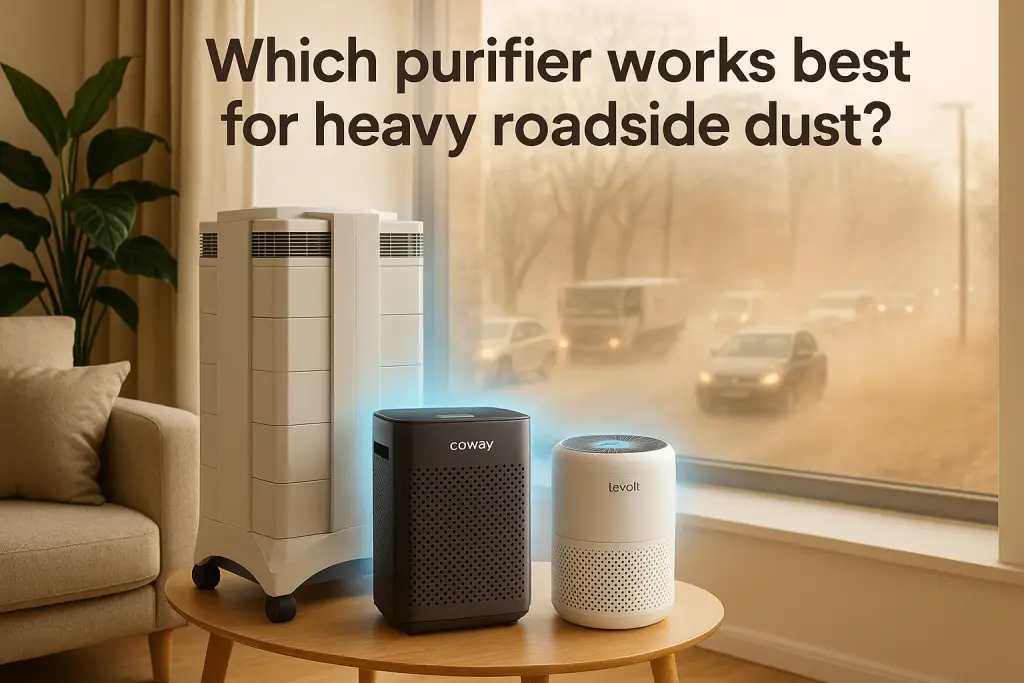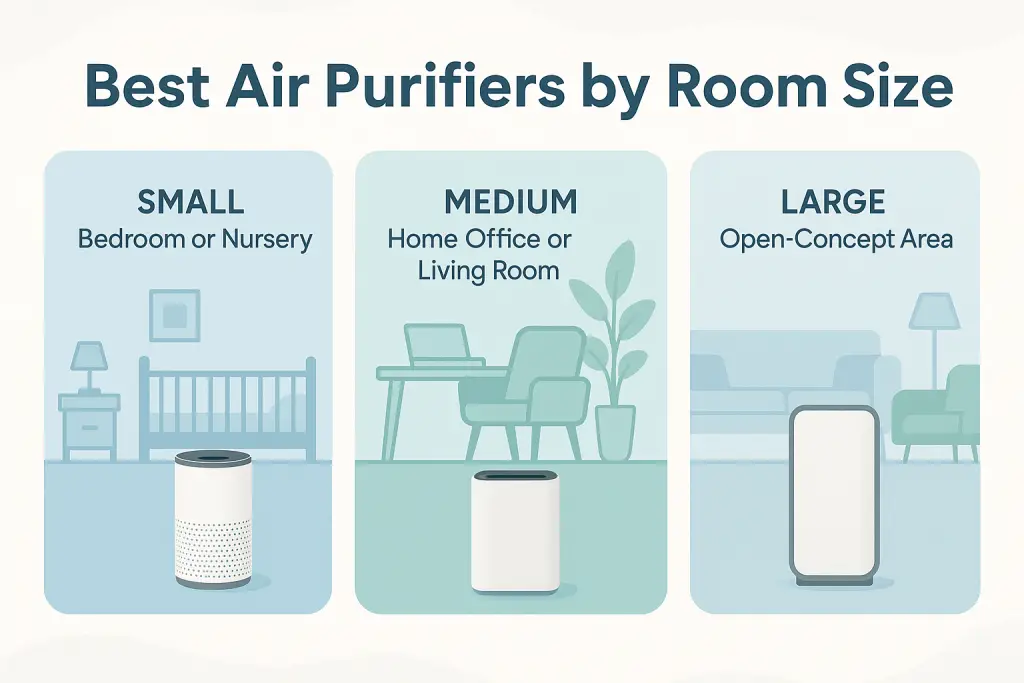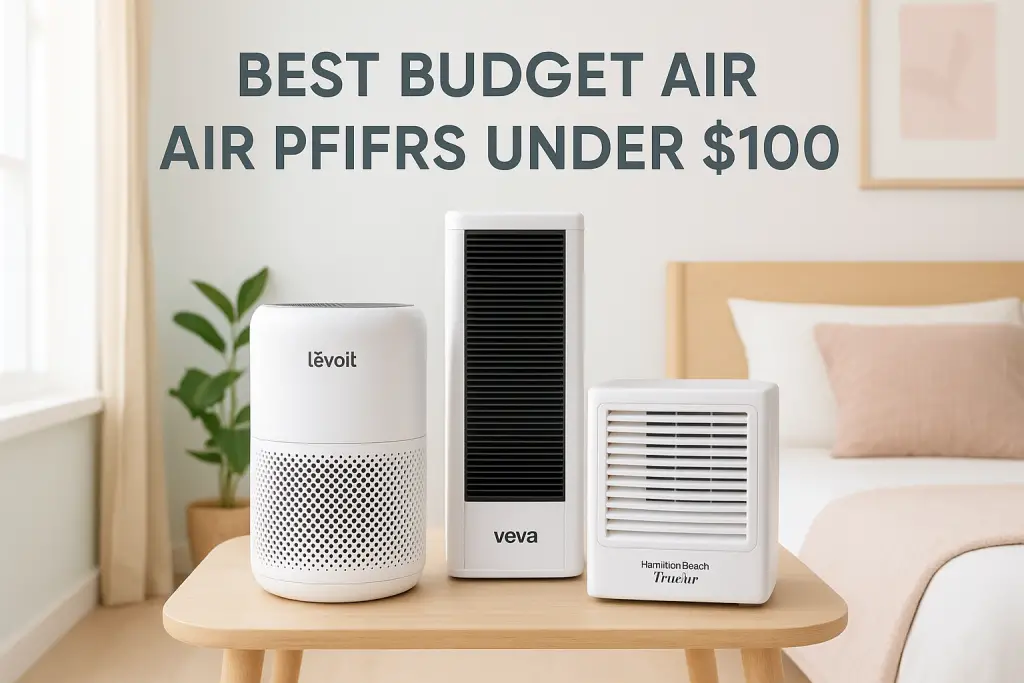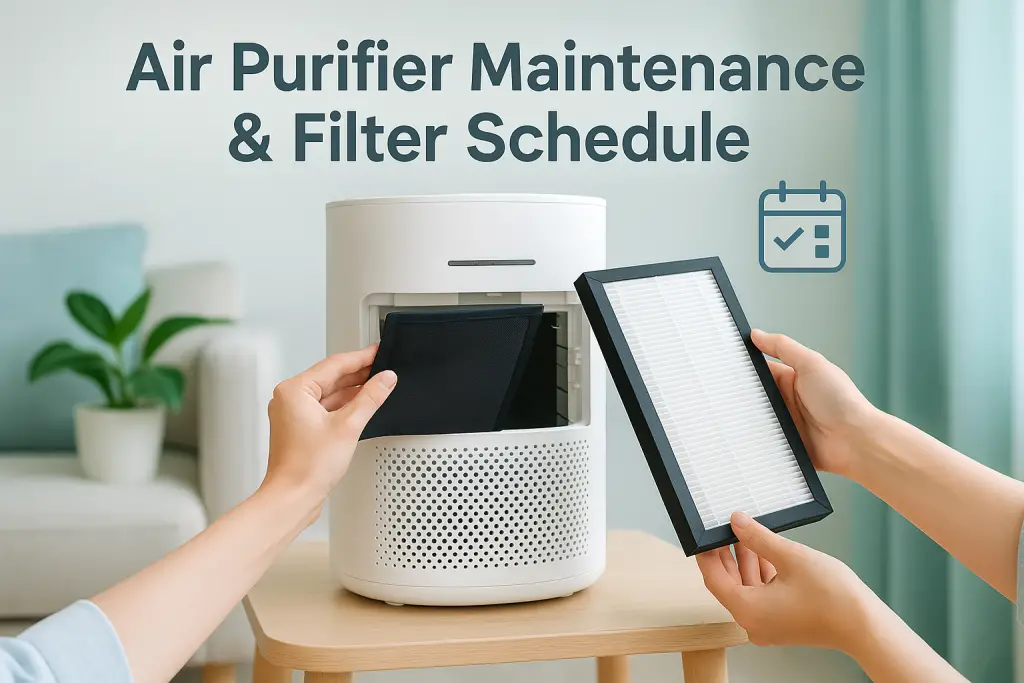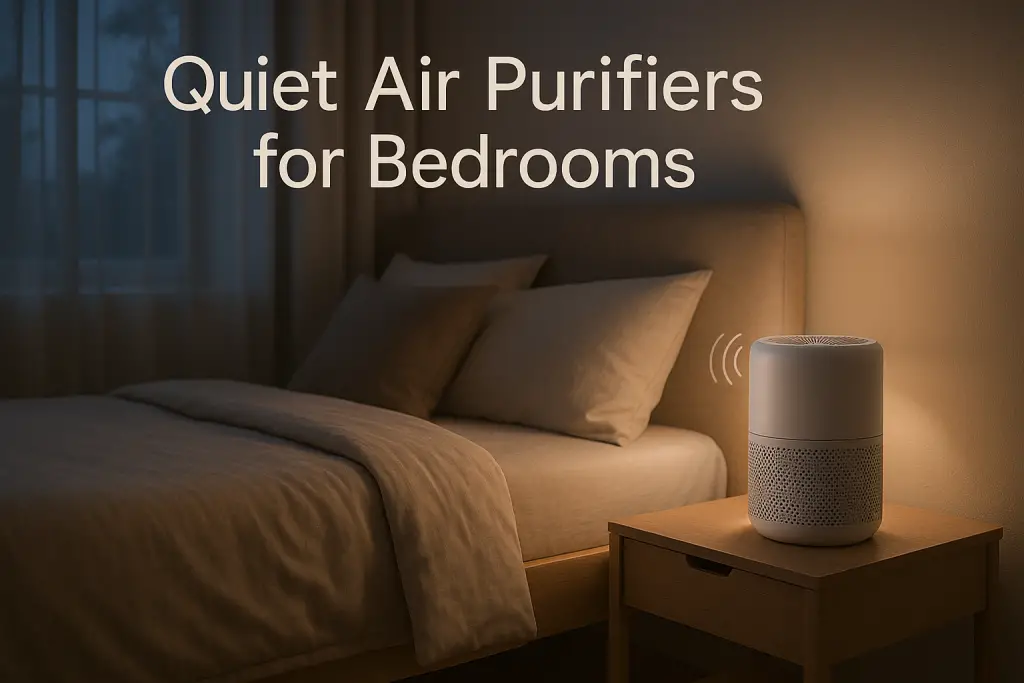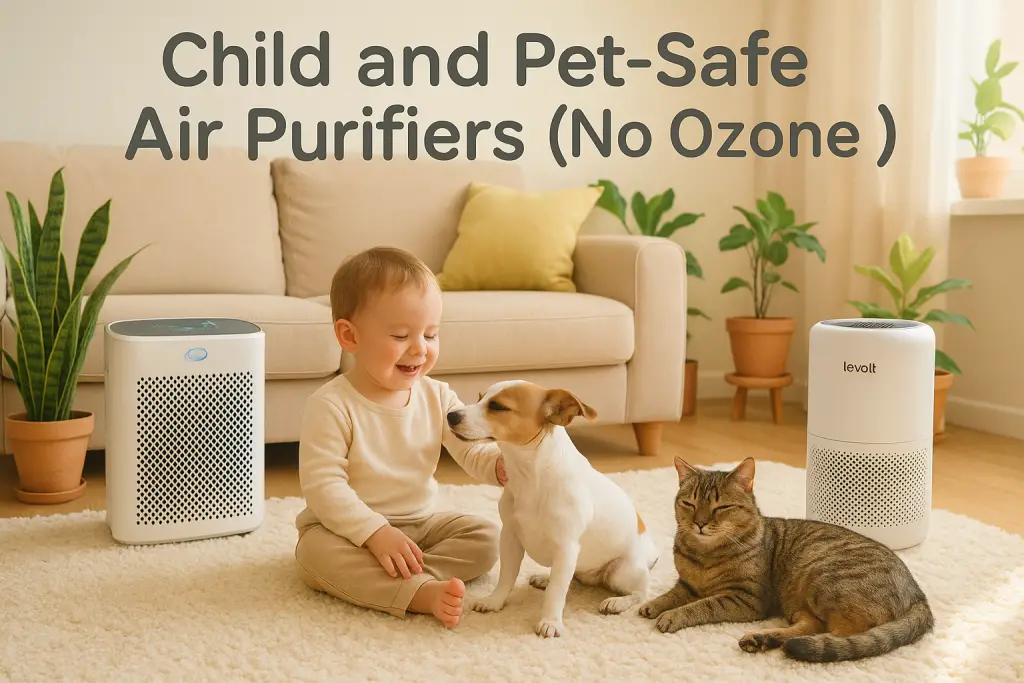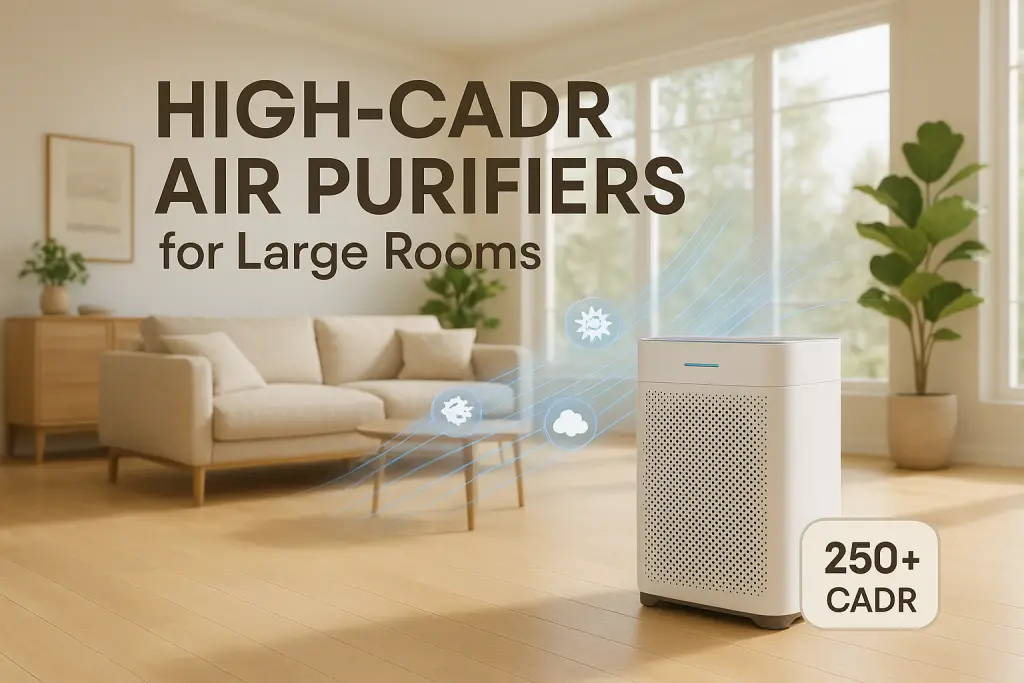Looking for the best air purifier to handle heavy roadside dust? Living near busy streets exposes your home to a unique mix of particulates that standard purifiers often struggle to capture. Roadside dust contains vehicle emissions, tire particles, and construction debris that require specialized filtration to effectively remove. The best air purifiers for roadside pollution combine True HEPA filtration, activated carbon layers, and high CADR ratings to tackle these challenging conditions. In this guide, we’ll explore what makes roadside dust different, which technologies work best, and our top recommendations to help you breathe cleaner air despite your location.
Understanding Roadside Dust: Why It’s Different and More Challenging
Roadside dust isn’t simply regular household dust that happens to come from outside. It contains a unique mixture of pollutants that makes it particularly difficult to filter effectively. Air purifiers can effectively capture dust particles, but roadside dust presents special challenges that require specific features.
The composition of roadside dust includes:
- Vehicle exhaust particles (including PM2.5 and ultrafine particles)
- Tire and brake wear particles (containing rubber compounds and metals)
- Road surface degradation (asphalt and concrete particles)
- Construction debris (when present nearby)
- Seasonal pollen that settles on road surfaces
What makes roadside dust particularly challenging is its particle size distribution. While regular household dust typically ranges from 10-40 microns, roadside dust contains a much higher percentage of particles smaller than 2.5 microns (PM2.5). These microscopic particles can penetrate deep into the lungs and even enter the bloodstream.
According to the EPA, PM2.5 concentrations can be 30-100% higher within 300 feet of major roads compared to background levels. This creates a significant health challenge for homes located near busy streets.
Health Risks Associated with Roadside Dust Exposure
Before exploring solutions, it’s important to understand why addressing roadside dust is crucial for your health. Long-term exposure to traffic-related air pollution is linked to numerous health problems.
The World Health Organization identifies these key health risks from roadside dust exposure:
- Increased risk of respiratory infections
- Development and worsening of asthma
- Reduced lung function growth in children
- Cardiovascular issues including heart attacks and stroke
- Higher rates of lung cancer in long-term exposure
Vulnerable populations face even greater risks, including children, older adults, pregnant women, and people with existing respiratory or cardiovascular conditions. Studies show that children living within 500 feet of major roads have a 50% higher risk of developing asthma and reduced lung capacity.
Key Technologies for Effectively Filtering Roadside Dust
Not all air purifier technologies are equally effective against the unique challenges posed by roadside dust. Here’s what actually works based on scientific evidence and real-world testing.
True HEPA Filtration: The Foundation for Roadside Dust Removal
True HEPA filters (High-Efficiency Particulate Air) are the gold standard for capturing the fine particles found in roadside dust. To qualify as True HEPA, filters must trap 99.97% of particles as small as 0.3 microns.
This is critical because:
- Most dangerous roadside particles fall within the 0.3-2.5 micron range
- “HEPA-type” or “HEPA-like” filters typically only capture 85-90% of particles
- True HEPA filters maintain efficiency even as they collect dust
Look for H13 or H14 HEPA classifications for the best protection against roadside particulates. These medical-grade filters capture even smaller particles with greater efficiency.
Activated Carbon: Essential for Gaseous Pollutants
Roadside air contains gaseous pollutants that HEPA filters alone can’t capture. Activated carbon adsorbs:
- Volatile organic compounds (VOCs) from vehicle exhaust
- Nitrogen oxides (NOx) from combustion engines
- Sulfur dioxide from diesel emissions
- Odors associated with traffic pollution
For effective roadside protection, look for purifiers with substantial carbon filters (at least 1-2 pounds of carbon). Thin carbon sheets or sprayed carbon provide minimal gas filtration.
Pre-Filtration: Critical for Filter Longevity
With the heavy particle load from roadside dust, a quality pre-filter is essential to:
- Capture larger dust particles before they reach the HEPA filter
- Extend the life of expensive HEPA filters
- Allow for easy cleaning without replacing the main filter
Washable pre-filters are ideal for roadside environments, as they can be cleaned weekly to maintain optimal airflow.
Filtration Technology Comparison for Roadside Dust
| Technology | Effectiveness for Roadside Dust | Limitations |
|---|---|---|
| True HEPA | Excellent (99.97% of particles ≥0.3μm) | Needs replacement; doesn’t capture gases |
| Activated Carbon | Good for gases and odors | Limited particle filtration |
| Electrostatic Precipitation | Good for ultrafine particles | May produce trace ozone; requires cleaning |
| UV Light | Poor for particles; targets microbes | Ineffective for dust; short bulb life |
| Ionizers | Moderate; helps particles settle | May produce ozone; requires surface cleaning |
Critical Specifications to Look for in Roadside Dust Purifiers
When evaluating air purifiers for roadside dust, specific technical specifications matter more than brand names or marketing claims. Choosing ozone-free purifier models is especially important for roadside environments where pollution levels are already elevated.
CADR Ratings: Clean Air Delivery Rate measures how much filtered air a purifier delivers. For roadside dust, look for:
- Dust CADR of at least 200 cfm for average rooms (up to 300 sq ft)
- Dust CADR of 300+ cfm for larger spaces
- Particle CADR should be prioritized over pollen or smoke ratings
Filter Efficiency: The percentage difference between True HEPA (99.97%) and HEPA-type (99.9%) may seem small, but it represents a significant gap in capturing the smallest, most dangerous roadside particles.
Air Exchange Rates: Look for purifiers that can perform 4-5 air changes per hour (ACH) for your room size. For roadside dust, higher ACH rates of 6+ are even better.
Filter Life in High-Dust Environments: Standard filter life ratings are based on typical indoor environments. For roadside dust, expect to replace filters 30-50% more frequently than manufacturer recommendations.
Which Purifier Works Best for Heavy Roadside Dust? Top 7 Recommendations
Based on our analysis of filter technology, real-world performance data, and user experiences in high-traffic areas, these seven air purifiers consistently outperform others specifically for roadside dust.
Best Overall: IQAir HealthPro Plus
The IQAir HealthPro Plus stands out as the most effective air purifier for heavy roadside dust, using a multi-stage filtration system specifically designed for high-pollution environments.
Why it excels for roadside dust:
- HyperHEPA filtration captures 99.97% of particles down to 0.3 microns and 95% of particles down to 0.003 microns
- V5-Cell gas and odor filter with 5 lbs of activated carbon and alumina
- PreMax pre-filter extends main filter life in high-dust environments
- 360° air intake maximizes dust capture from all directions
- Covers up to 1,125 sq ft with 2 air changes per hour
Limitations: Higher price point ($899-$999), bulkier design, and fan noise at highest speeds.
Real users living near highways report significant reductions in visible dust accumulation within days of installation, and many note improvements in respiratory symptoms within weeks.
Best Value: Coway Airmega AP-1512HH
The Coway Airmega offers exceptional roadside dust performance at a mid-range price point, making it our top value pick.
Key features for roadside dust:
- True HEPA filtration capturing 99.97% of particles
- Substantial activated carbon filter for traffic exhaust gases
- Washable pre-filter that’s easy to maintain in high-dust environments
- Air quality indicator that shows pollution levels in real-time
- Auto mode adjusts fan speed based on detected particle levels
- Covers spaces up to 361 sq ft with excellent efficiency
Limitations: Smaller carbon filter than premium models, covers less area than larger units.
At around $230, the Coway delivers performance comparable to units costing twice as much, with filter replacement costs of about $70 annually.
Best Budget Option: Levoit Core 300
For those needing roadside dust protection on a budget, the Levoit Core 300 offers impressive performance at an accessible price point.
Features for roadside dust:
- H13 True HEPA filter capturing 99.97% of particles down to 0.3 microns
- Activated carbon filter layer for traffic exhaust
- 360° air intake design maximizes dust capture
- Quiet operation (24dB on sleep mode)
- Compact design for bedrooms or offices up to 219 sq ft
- Filter replacement indicator
Limitations: Smaller coverage area, less powerful motor, smaller carbon filter.
At approximately $100 with $30 filter replacements, the Core 300 provides solid roadside dust protection for smaller spaces without breaking the budget. This purifier also works well for other smoke and particulate concerns, making it versatile for different pollution types.
Best for Large Rooms: Blueair Blue Pure 211+
For larger spaces facing roadside dust challenges, the Blueair Blue Pure 211+ delivers exceptional performance with straightforward operation.
Standout features for roadside environments:
- HEPASilent filtration technology (99.97% of particles)
- Activated carbon layer for traffic gases and odors
- Washable pre-filter available in multiple colors
- Exceptionally high CADR of 350 cfm for dust
- Covers up to 540 sq ft with 5 air changes per hour
- Simple one-button operation
Limitations: No air quality sensor, limited smart features, louder at highest setting.
At approximately $300 with yearly filter costs of $70, the 211+ delivers outstanding performance for larger living rooms, open concepts, or studio apartments near busy roads.
Best for Extreme Roadside Pollution: Austin Air HealthMate Plus
For homes facing severe roadside pollution from major highways, construction zones, or unpaved roads, the Austin Air HealthMate Plus offers industrial-grade filtration.
Features for extreme roadside dust:
- Medical-grade HEPA capturing 99.97% of particles
- Massive 15 lbs of activated carbon, zeolite, and potassium iodide
- 360° perforated intake screen
- 5-year filter life (longest in the industry)
- All-metal construction for durability
- Covers up to 1,500 sq ft
Limitations: Heavier unit (45 lbs), industrial design, no smart features.
At approximately $715 with a filter that lasts 5 years (amortized cost of about $100/year), the Austin Air represents excellent long-term value for severe roadside pollution scenarios.
Best Smart Purifier: Dyson Purifier Cool TP07
For tech-savvy users wanting detailed insights about roadside pollution, the Dyson TP07 combines effective filtration with comprehensive monitoring.
Smart features for roadside environments:
- HEPA H13 standard filtration
- Activated carbon with potassium-enriched carbon for improved gas capture
- Real-time air quality monitoring with particle and gas sensors
- Smartphone app showing pollution levels over time
- Auto mode adjusts to detected roadside pollution spikes
- Oscillation feature for wider coverage
- Doubles as a cooling fan
Limitations: Premium pricing, higher filter replacement costs, coverage area not as large as dedicated units.
At approximately $550 with yearly filter costs of $80, the Dyson offers excellent filtration with the best monitoring capabilities for users who want detailed data about their roadside pollution exposure.
Best Portable Option: Winix 5500-2
For users needing flexibility to move their purifier between rooms affected by roadside dust, the Winix 5500-2 offers excellent performance with reasonable portability.
Features for roadside dust:
- True HEPA filtration (99.97%)
- Carbon filter with control odors
- PlasmaWave technology for additional particle control
- Air quality sensor with auto mode
- Handles for easier movement
- Covers up to 360 sq ft
Limitations: PlasmaWave can be disabled if concerned about any ozone, moderate weight for frequent moving.
At approximately $160 with yearly filter costs of $80, the Winix offers excellent value with the flexibility to target different rooms affected by roadside dust.
Strategic Placement for Maximum Roadside Dust Capture
Where you place your air purifier is just as important as which model you choose when dealing with roadside dust infiltration. Proper air purifier placement significantly impacts performance, especially in homes facing roadside pollution.
Room Prioritization Strategy:
- Rooms facing the road – These receive the highest dust exposure and should get your best purifier
- Bedrooms – Since you spend 6-8 hours here daily, these are critical for health protection
- Living areas – Common spaces where family members gather for extended periods
- Home office – Important if you work from home
Optimal Placement Within Rooms:
- Position purifiers 3-6 feet from walls for proper air circulation
- Place units perpendicular to the main airflow path from windows/doors to intercept incoming dust
- Keep purifiers at least 3 feet from furniture or obstacles
- For bedrooms, position 4-6 feet from the bed for optimal nighttime protection
- Avoid corners where air circulation is limited
Distance from Windows: For rooms facing roads, position purifiers 6-10 feet from windows. This creates a filtration zone that captures dust as it infiltrates, rather than placing the unit directly at the window where it can be overwhelmed.
Creating a Multi-Layered Defense Against Roadside Dust
For homes in particularly challenging roadside environments, a single air purifier may not be sufficient. Here’s how to create a comprehensive dust defense system.
Primary and Secondary Purifier Strategy:
- Use your highest-capacity purifier in the room most affected by roadside dust
- Place secondary units in connected spaces to create a cascade of clean air
- For open floor plans, position multiple smaller units rather than one large unit
Complementary Measures:
- Seal windows facing roads with weatherstripping
- Use door sweeps to prevent dust infiltration under doors
- Consider window films that reduce air infiltration
- Keep windows closed during high traffic periods (rush hour)
- Create positive pressure by placing a window fan blowing inward on the side of the house away from the road
HVAC Integration: Install MERV 13 or higher filters in your home HVAC system as a first line of defense, complementing standalone purifiers. Some advanced air purifiers can be connected to existing ductwork for whole-house filtration.
Maintenance Requirements for Air Purifiers in Heavy Dust Environments
Air purifiers in roadside environments require more frequent and thorough maintenance than those in standard conditions. Here’s a complete maintenance schedule to ensure optimal performance.
Filter Replacement Timeline for Roadside Dust
Heavy roadside dust significantly shortens filter life. Use this adjusted timeline:
- Pre-filters: Clean every 2-4 weeks (2-3x more often than manufacturer recommendations)
- HEPA filters: Replace every 4-6 months for severe roadside pollution (compared to 12 months standard)
- Carbon filters: Replace every 3-4 months for heavy traffic areas (gases saturate filters faster than particles)
Signs Your Filter Needs Immediate Replacement:
- Visible gray or black discoloration across the entire filter surface
- Noticeable decrease in airflow even at highest fan setting
- Purifier no longer reducing visible dust accumulation on surfaces
- Return of traffic odors in the home
- Air quality monitor shows consistently higher readings
Maintenance Cost Calculations: For homes with heavy roadside dust, budget approximately 1.5-2x the manufacturer’s suggested filter replacement costs annually. For a mid-range purifier, this typically means $150-250 per year in filter costs.
Extending Filter Life Without Compromising Performance
The heavy particle load from roadside dust can quickly overwhelm filters, leading to frequent replacements and higher costs. Using auto mode features effectively can help extend filter life by running the purifier at appropriate speeds based on current pollution levels.
Pre-Filter Enhancement:
- Add a washable mesh screen in front of the pre-filter for larger particles
- Vacuum pre-filters weekly instead of just washing monthly
- For non-washable pre-filters, use compressed air to clean between replacements
Operation Scheduling:
- Run on highest setting during rush hour periods
- Use medium settings overnight when traffic is lighter
- Operate at low speed when away from home for background filtration
Complementary Dust Reduction:
- Damp mop floors twice weekly to reduce dust recirculation
- Use microfiber cloths for dusting surfaces
- Wash bedding weekly in hot water
- Remove shoes at the entrance to prevent tracking in road dust
Measuring Effectiveness: How to Know if Your Air Purifier is Working
With roadside dust being particularly challenging, it’s important to verify that your air purifier is actually performing as expected. Here are concrete ways to measure effectiveness.
Quantitative Measurement Methods
Air Quality Monitors: For roadside environments, invest in a monitor that specifically measures PM2.5 particles. Quality options include:
- Temtop M10 Air Quality Monitor ($89.99) – Measures PM2.5 and provides numerical readings
- IQAir AirVisual Pro ($269) – Provides detailed particle counts and historical data
- Awair Element ($299) – Tracks multiple pollutants and connects to smart home systems
Before/After Testing Protocol:
- Take baseline measurements at different times of day before purifier installation
- Install and run purifier at highest setting for 2 hours
- Take new measurements in the same locations
- Compare results – effective purifiers should show 80%+ reduction in PM2.5 levels
Long-Term Effectiveness Tracking:
- Log PM2.5 readings daily at consistent times (morning and evening)
- Track how quickly levels return to acceptable range after opening windows
- Note how readings change during high traffic periods vs. low traffic periods
Using Air Quality Monitors with Your Roadside Dust Purifier
An air quality monitor can transform how effectively you manage roadside dust by providing real-time feedback on your air purifier’s performance.
Monitor Placement:
- Position 6-10 feet away from the purifier
- Keep at breathing height (3-4 feet when seated, 5-6 feet when standing)
- Avoid placing near windows where readings fluctuate rapidly
- Don’t place directly in airflow path from the purifier
Interpreting PM2.5 Readings:
- 0-12 μg/m³: Excellent – Purifier is working effectively
- 12-35 μg/m³: Moderate – Acceptable for healthy adults but not ideal
- 35-55 μg/m³: Unhealthy for sensitive groups – Increase purifier speed or add units
- 55+ μg/m³: Unhealthy – Immediate action needed (check filters, add units)
Smart Integration: Some monitors can connect directly to compatible purifiers, automatically adjusting settings based on detected pollution levels. This automation helps maintain consistent air quality while optimizing filter life.
FAQ: Common Questions About Air Purifiers for Roadside Dust
Based on our research and user feedback, these are the most common questions people have when selecting and using air purifiers specifically for roadside dust conditions.
How are purifiers for roadside dust different from standard air purifiers?
Purifiers designed for roadside dust have stronger motors for higher airflow, larger activated carbon filters for traffic exhaust gases, and often use H13 or H14 grade HEPA filters rather than standard H11. They’re built to handle heavier particulate loads and need more frequent maintenance.
Do I need multiple purifiers if I live on a busy road?
For most homes facing busy roads, multiple smaller purifiers strategically placed work better than one large unit. While purifiers are effective for indoor air, you might still need masks when outdoors in heavy roadside pollution areas. Focus on rooms facing the road and bedrooms first.
Are HEPA filters enough, or do I need additional technologies?
True HEPA is essential but not sufficient for roadside pollution. You also need substantial activated carbon (at least 1 pound) to address traffic exhaust gases. Pre-filters are critical for extending HEPA life in heavy dust environments.
How much more often will I need to replace filters near a busy road?
Expect to replace filters 1.5-2x more frequently than manufacturer recommendations. Pre-filters may need cleaning weekly rather than monthly, HEPA filters every 4-6 months rather than annually, and carbon filters every 3-4 months due to faster saturation from traffic gases.
Can air purifiers remove ultrafine diesel particles from roadway traffic?
Standard HEPA filters capture 99.97% of particles at 0.3 microns, but diesel particles can be as small as 0.1 microns. H13 and H14 HEPA filters, along with some electrostatic technologies, can capture these ultrafine particles with 85-95% efficiency.
How do seasonal changes affect roadside dust filtration?
Winter typically requires more filtration as closed windows trap pollution, while summer brings pollen that combines with road dust. Rainy seasons temporarily reduce roadside dust but increase humidity that can affect filter performance. Adjust maintenance schedules seasonally.
Do air purifiers help with traffic noise as well as dust?
Air purifiers do not significantly reduce traffic noise. For noise reduction, consider weatherstripping windows, installing acoustic panels, using white noise machines, or installing soundproof curtains in addition to your air purification strategy.
Are smart features worth the extra cost for roadside dust purifiers?
Smart features provide particular value in roadside environments where pollution levels fluctuate with traffic patterns. Auto-mode features that adjust to pollution spikes during rush hour can optimize filtration while extending filter life during low-traffic periods.
How can I tell if my purifier is actually capturing roadside dust?
Besides using air quality monitors, check your pre-filter weekly – it should show visible dust accumulation. You should also notice less dust on surfaces near the purifier and experience fewer respiratory symptoms over time. Those with allergies and asthma may notice significant symptom improvement when proper filtration is working.
Conclusion: Creating a Roadside Dust-Free Home Environment
Living near a busy road doesn’t mean you must accept poor air quality. With the right air purifier, strategic placement, and proper maintenance, you can dramatically reduce roadside dust in your home.
For most homes facing roadside dust challenges, the Coway Airmega AP-1512HH offers the best balance of performance, value, and maintenance costs. For those with more severe roadside pollution or larger spaces, the IQAir HealthPro Plus provides hospital-grade filtration that can transform even the most challenging roadside environments.
Remember these key action steps:
- Choose a purifier with True HEPA and substantial activated carbon
- Place units strategically in rooms facing roads and bedrooms
- Clean pre-filters weekly in roadside environments
- Replace filters more frequently than standard recommendations
- Consider a multi-purifier approach for whole-home protection
- Use an air quality monitor to verify performance
By following these guidelines, you can create a clean air sanctuary despite living near busy roads. The investment in proper air purification pays dividends in both immediate comfort and long-term health protection for you and your family.
| Photo | Air Purifier Model | Best for | Price |
|---|---|---|---|

|
WINIX A231 Air Purifier | Asthma & Indoor Pollution | Check Price On Amazon |

|
Rabbit Air, A3 SPA-1000N Air Purifier | Pet Dander & Odors | Check Price On Amazon |

|
LEVOIT Air Purifier | Best Overall | Check Price On Amazon |

|
GermGuardian Air Purifier | Cigarette & Cooking Smoke | Check Price On Amazon |

|
Coway Airmega Air Purifier | New-borns | Check Price On Amazon |

|
BLUEAIR Air Purifier | Germ & Virus Control | Check Price On Amazon |
